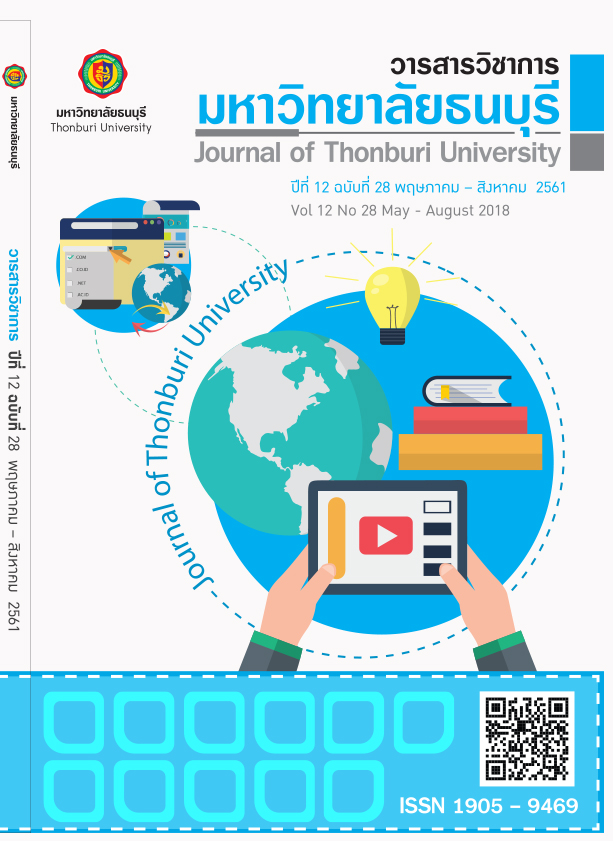การยอมรับการใช้โมบายเซอร์วิสเทคโนโลยีในอุดมศึกษา
บทคัดย่อ
บทคัดย่อ
ปัจจุบันเทคโนโลยีสารสนเทศและการสื่อสารเข้ามามีบทบาทการจัดการศึกษาระดับอุดมศึกษา โดยเฉพาะอย่างยิ่งเทคโนโลยีโมบายเซอร์วิส เนื่องจากการพัฒนาเทคโนโลยีใหม่ๆ บทความนี้มีวัตถุประสงค์เพื่อให้ความรู้เกี่ยวกับการยอมรับการใช้โมบายเซอร์วิสเทคโนโลยีในอุดมศึกษา แนวคิดและงานวิจัยที่เกี่ยวข้องของต่างประเทศ ซึ่งทำให้ทราบถึงปัจจัยสนับสนุนในการเลือกใช้โมบายเซอร์วิส รูปแบบการยอมรับการใช้โมบายเซอร์วิสในอุดมศึกษา และรูปแบบสมการโครงสร้าง เพื่อให้สามารถเลือกใช้ทฤษฎีการยอมรับเทคโนโลยีเป็นกรอบอ้างอิงได้อย่างเหมาะสม ซึ่งรูปแบบการยอมรับเทคโนโลยีที่ใช้กันทั่วไป ได้แก่ TAM, TAM2, UTAUT, หรือ IDT ซึ่งมีข้อดีคือ มีความยืดหยุ่น ผู้ศึกษาสามารถเพิ่มปัจจัยที่เกี่ยวข้องกับเทคโนโลยีที่ต้องการศึกษา หรือตัดปัจจัยที่ไม่เกี่ยวข้องกับเทคโนโลยีที่ศึกษาได้ตามความเหมาะสมแต่อาจเลือกศึกษารูปแบบการยอมรับเทคโนโลยีที่เป็นแบบเฉพาะแบบโมบายเซอร์วิส เช่น Mobile services Acceptance model ซึ่งเป็นรูปแบบเฉพาะสำหรับการยอมรับโมบายเซอร์วิสเทคโนโลยี ซึ่งมีข้อดีคือ รูปแบบการยอมรับเทคโนโลยีดังกล่าวได้ถูกจัดเตรียมไว้เหมาะกับโมบายเซอร์วิสแล้วและสามารถนำไปใช้ได้ทันที แต่มีข้อเสียคือ หากโมบายเซอร์วิสในอุดมศึกษาที่นำไปใช้งานมีบริบทที่แตกต่างจากรูปแบบที่เตรียมไว้ก็จะไม่สามารถตรวจสอบสมมุติฐานได้อย่างแท้จริง ด้วยเหตุนี้ผู้ศึกษาจึงควรพิจารณารูปแบบการยอมรับเทคโนโลยีที่เหมาะสมกับบริบทของโมบายเซอร์วิสในอุดมศึกษา
คำสำคัญ: รูปแบบการยอมรับเทคโนโลยี, รูปแบบการยอมรับการใช้โมบายเซอร์วิส, รูปแบบการยอมรับการใช้โมบายเซอร์วิสในอุดมศึกษา
Abstract
Nowadays, information and communication technology plays a role in higher education. Especially mobile technology. Due to the development of new technologies. This article is intended to provide knowledge about the adoption of mobile technology services in higher education. Concepts and related research of foreign countries. This gives us an insight into the support factors for choosing a mobile service. Acceptance of mobile service in higher education and form the structural equation model. To be able to adopt the theory of technology adoption as a reference frame. The most commonly accepted technology adoption models are TAM, TAM2, UTAUT, or IDT. This has the advantage. Flexible Educators can add factors related to the technology they want to study. Or cut off factors that are not related to the technology studied as appropriate. However, it may be appropriate to study the adoption model of mobile-specific technology such as Mobile services Acceptance model. This is a specialized model for the adoption of mobile technology services. This has the advantage. The technology adoption model has been optimized for mobile services and can be used immediately. But there are disadvantages. If the mobile service in higher education deploys a context different from the one provided, it will not be able to truly verify the hypothesis. For this reason, researchers should consider a technology adoption model appropriate to the context of mobile services in higher education.
Keyword: Technology Acceptance Model, mobile services acceptance model, mobile services acceptance model in higher education







